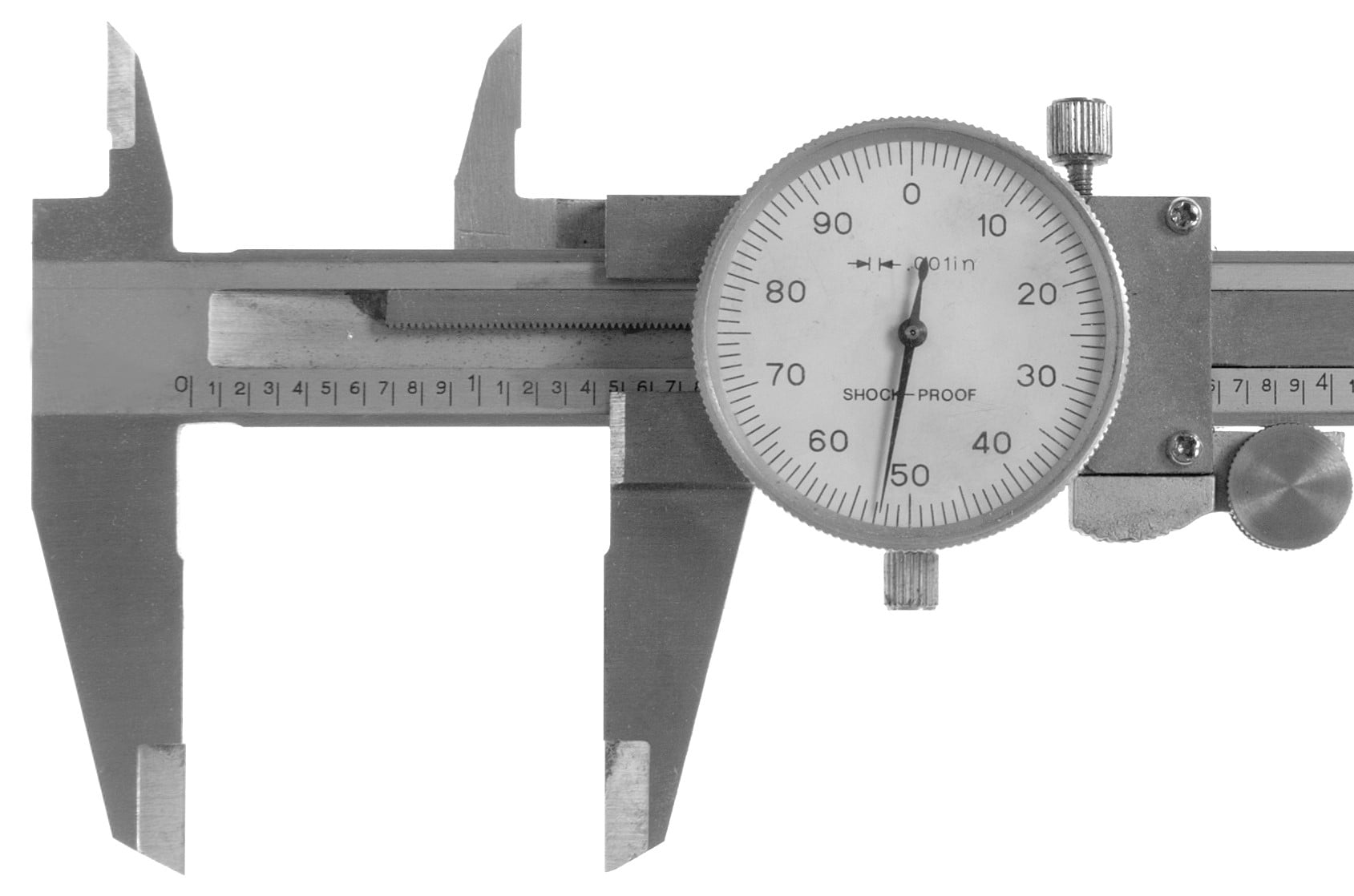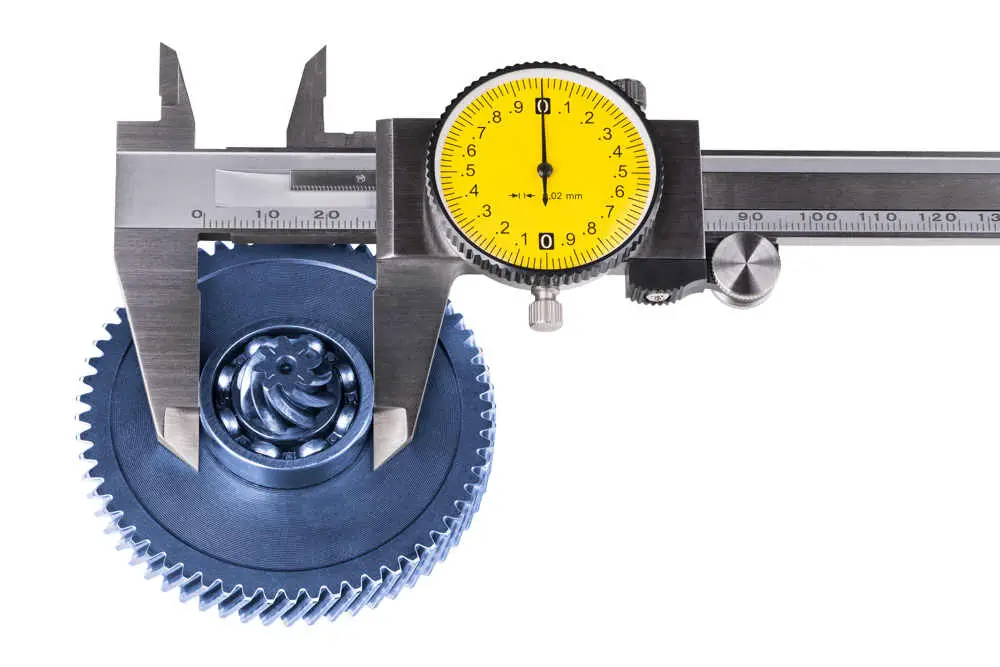Learning about how to read a dial caliper is about learning how to read its main and dial scale. The main scale is linear like the ruler, while the dial/secondary scale is circular. Simply, if you ask how to read dial caliper, you have to master these two scales.
There is an imperial or metric dial caliper. The commonly used dial caliper on the U.S. market is the imperial dial caliper. As the name suggests, it comes with an inch graduation system and can provide down to a resolution of 0.001″. The metric-based dial caliper (graduated in mm) can come with a resolution down to 0.02 mm. Some dial calipers even provide both inches and mm graduation.
For some people, reading the dial caliper may not be as intuitive as reading the digital caliper. The main issue of this difficulty may lay in the dial scale reading. However, it’s considered easier than reading the vernier caliper. The dial scale graduation is clearer and easier to read.
This post has a purpose to guide you on how to read dial caliper. You will be learning to count the main and dial scale, take the zero error into account and calculate the final reading. Additionally, you will learn how to read dial caliper whether in inches, mm, or fractions. Especially reading the fractional dial caliper, it is quite different. So, you should not miss it.
General Formula
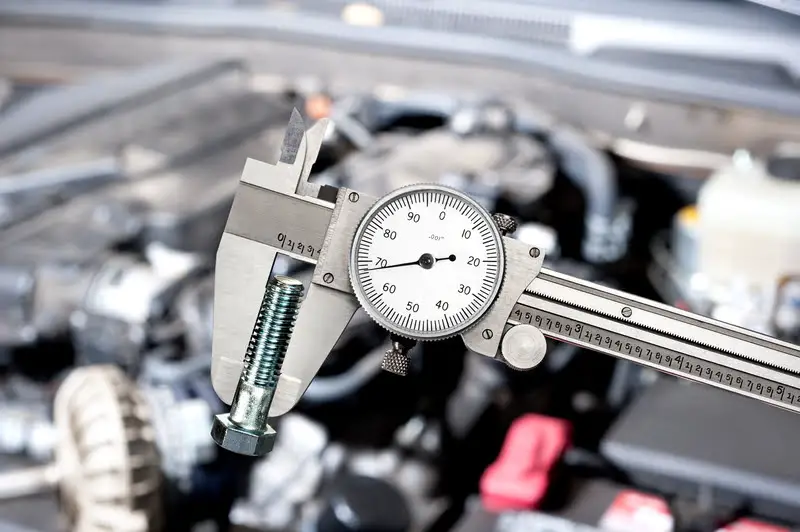
Basically, reading the dial caliper is like reading the vernier caliper. You have to calculate all the component readings to get the core final reading.
Main Scale Reading + Dial Scale Reading − Zero Error = Final Reading
- Main scale reading = the divisions passed by the jaw from “0” × main scale’s smallest division value.
- Dial scale reading = the divisions passed by the needle from “0” × dial scale’s smallest division value.
- Zero error = the divisions passed by the needle from “0” for both closed jaws × dial scale’s smallest division value.
Zero error is an unwanted reading when you close the jaws. It shows a certain reading, while it should give a reading of 0″ or 0 mm (no zero error). This zero error value can be negative or positive.
Before you do the calculation, you have to know the smallest division’s value of both the main and the dial scale — we will multiply those two values with the counted divisions of the scales later on.
Generally, the dial caliper manufacturer will let you know the smallest reading of each scale by marking it. You can notice it on your dial caliper. However, for learning purposes, you need to know where it comes from. So, in case the dial caliper that you are using has no information about it, you always know what to do.
Main Scale’s Smallest Division Value
Commonly, the smallest division of the main scale has a value of 0.1″. This is generated from the graduation of the main scale that has 10 divisions per 1″.
1″ : 10 divisions = 0.1″
Dial Scale’s Smallest Division Value
The dial scale functions to magnify the main scale’s smallest division. And many dial scales have 100 division graduation. If the sliding jaw moves for 0.1″, at the same time, the needle travels for 100 divisions (0.1″ of the main scale equals one full rotation), then the value of the dial scale’s smallest division is:
0.1″ : 100 divisions = 0.001″
Some dial scales come with 200 division graduation. If the sliding jaw moves for 0.2″, at the same time, the needle travels around for 200 divisions (0.2″ of the main scale equals one full rotation), then the value of the main scale’s smallest division is:
0.2″ : 200 divisions = 0.001″
After defining those two smallest values, now you could get into the general formula mentioned before.
1. How to Read Dial Caliper in inches
a. Dial Caliper Reading Example 1
The following dial caliper has 10 divisions per 1″ on its main scale and 200 divisions per one full rotation on its dial scale. If the jaw moves for 2/10 inch (0.2″), the needle moves for one complete rotation.
It means that:
- main scale’s smallest division value is 0.1″ (1″ : 10 divisions).
- dial scale’s smallest division value is 0.001″ (0.2″ : 200 divisions).
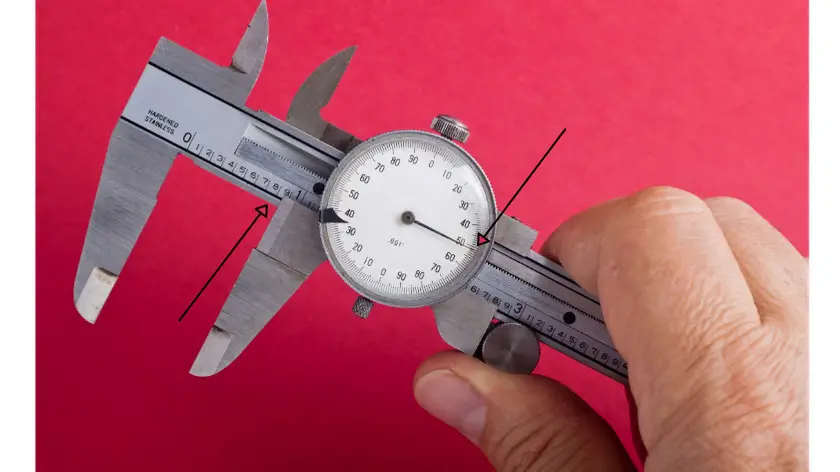
If the smallest reading has been defined, we can go to the next step.
1. Main Scale Reading
Take a look at the left pointer. The amount of divisions passed by the sliding jaw is 8 and the smallest division value of the main scale is 0.1″.
Divisions passed by jaw × Smallest division value of the main scale = Main scale reading
8 × 0.1″ = 0.8″
2. Dial Scale Reading
Look at the right pointer. The amount of divisions passed by the needle is 51 and the smallest division value of the dial scale is 0.001″.
Divisions passed by needle × Smallest division value of the dial scale = Dial scale reading
51 × 0.001″ = 0.051″
3. Zero Error
When the jaws are closed, suppose that the needle points out “0” which means it has no zero error.
0 × 0.001″ = 0″
4. Final Reading
Main scale reading + Dial scale reading − Zero Error = Final reading
0.8″ + 0.051″ − 0″ = 0.851″
b. Dial Caliper Reading Example 2
The following dial caliper has 10 divisions per inch on its main scale and 100 divisions per full rotation on its dial scale.
It means that:
- main scale’s smallest division value is 0.1″ (1″ : 10 divisions).
- dial scale’s smallest division value is 0.001″ (0.1″ : 100 divisions).
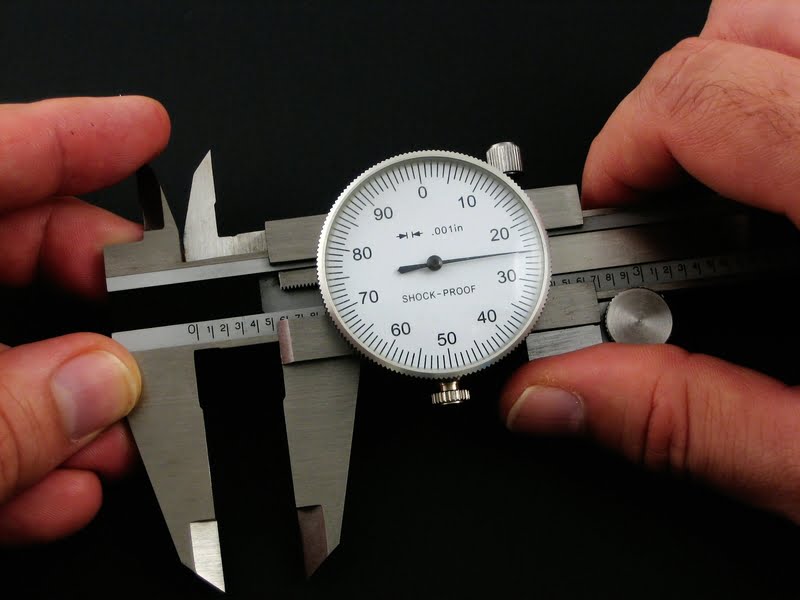
1. Main Scale Reading
The divisions passed on the main scale × Smallest division value of the main scale = Main scale reading
5 × 0.1″ = 0.5″
2. Dial Scale Reading
The divisions passed on the dial scale × Smallest division value of the dial scale = Dial scale reading
25 × 0.001″ = 0.025″
3. Zero Error
The needle points out “0” when the jaws are closed.
0 × 0.001″ = 0″
4. Final Reading
Main scale reading + Dial scale reading − Zero error reading = Final reading
0.5″ + 0.025″ − 0″ = 0.525″
c. Dial Caliper Reading Example 3
The following image shows us that:
- main scale’s smallest division value is 0.1″ (1″ : 10 divisions).
- dial scale’s smallest division value is 0.001″ (0.1″ : 100 divisions).
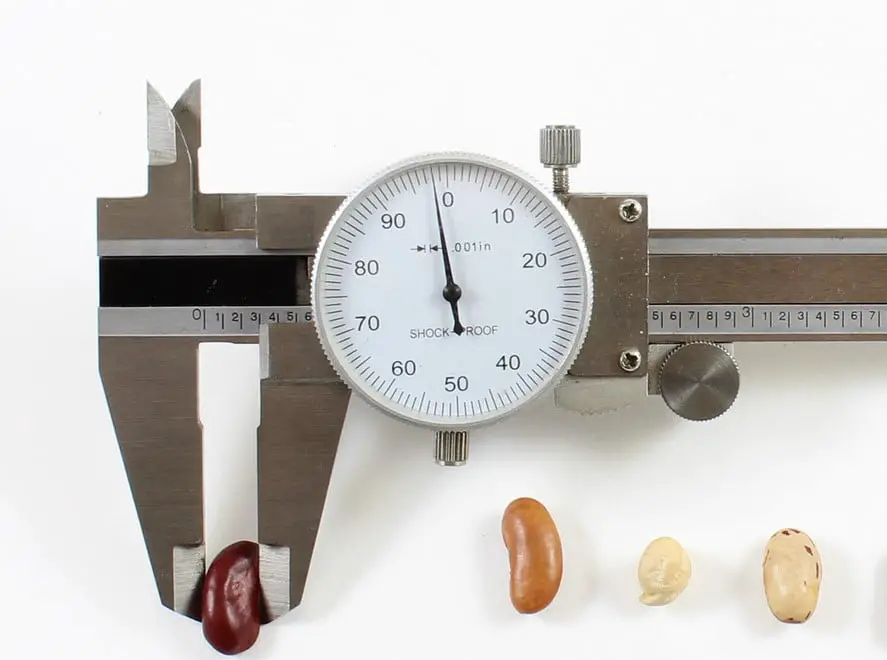
1. Main Scale Reading
The divisions passed on the main scale × Smallest division value of the main scale = Main scale reading
2 × 0.1″ = 0.2″
2. Dial Scale Reading
The divisions passed on the dial scale × Smallest division value of the dial scale = Dial scale reading
98 × 0.001″ = 0.098″
3. Zero Error
The needle points out “0” when the jaws are closed.
0 × 0.001″ = 0″
4. Final Reading
Main scale reading + Dial scale reading − Zero error reading = Final reading
0.2″ + 0.098″ − 0″ = 0.298″
d. Dial Caliper Reading Example 4
The following image tells us that:
- main scale’s smallest division value is 0.1″ (1″ : 10 divisions).
- dial scale’s smallest division value is 0.001″ (0.1″ : 100 divisions).
1. Main Scale Reading
The divisions passed on the main scale × Smallest division value of the main scale = Main scale reading
14 × 0.1″ = 1.4″
2. Dial Scale Reading
The divisions passed on the dial scale × Smallest division value of the dial scale = Dial scale reading
53 × 0.001″ = 0.053″
3. Zero Error
Suppose that the needle points out “1” when the jaws are closed. This is a positive zero error.
1 × 0.001″ = 0.001″
4. Final Reading
Main scale reading + Dial scale reading − Zero error reading = Final reading
1.4″ + 0.053″ − 0.001″ = 1.452″
e. Dial Caliper Reading Example 5
The following image shows us that:
- main scale’s smallest division value is 0.1″ (1″ : 10 divisions).
- dial scale’s smallest division value is 0.001″ (0.1″ : 100 divisions).
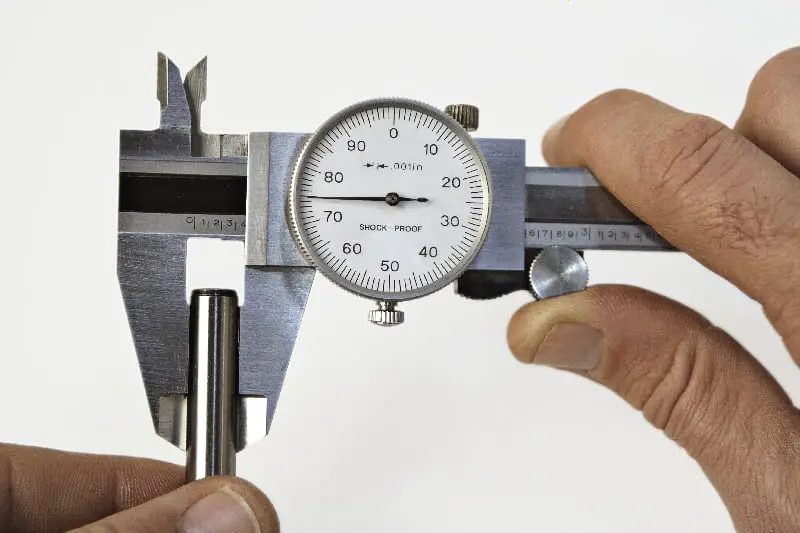
1. Main Scale Reading
The divisions passed on the main scale × Smallest division value of the main scale = Main scale reading
3 × 0.1″ = 0.3″
2. Dial Scale Reading
The divisions passed on the dial scale × Smallest division value of the dial scale = Dial scale reading
75 × 0.001″ = 0.075″
3. Zero Error
Suppose that the needle points out “99” when the jaws are closed. This is a negative zero error.
−1 × 0.001″ = −0.001″
4. Final Reading
Main scale reading + Dial scale reading − Zero error reading = Final reading
0.3″ + 0.075″ − (−0.001″) = 0.376″
2. How to Read Dial Caliper in mm (millimeter)
The following image lets us know that:
- main scale’s smallest division value is 1 mm (1 cm : 10 divisions)
- dial scale’s smallest division value is 0.02 mm (2 mm : 100 divisions)
1. Main Scale Reading
The divisions passed on the main scale × Smallest division value of the main scale = Main scale reading
28 × 1 mm = 28 mm
2. Dial Scale Reading
The divisions passed on the dial scale × Smallest division value of the dial scale = Dial scale reading
0 × 0.02 mm = 0 mm
3. Zero Error
The needle points out “0” when the jaws are closed.
0 × 0.02 mm = 0 mm
4. Final Reading
Main scale reading + Dial scale reading − Zero error reading = Final reading
28 mm + 0 mm − 0 mm = 28 mm
3. How to Read Dial Caliper in Fractions
When it comes to the dial caliper with a fractional graduation system, the dial scale doesn’t magnify the main scale like the way the inch-and-mm-based dial calipers do.
That’s because 1″ of the main scale is equal to one full rotation of the dial scale. The dial scale is divided into 64 divisions. So, each division is 1/64″.
From this graduation system, you could also conclude that each smallest division of the main scale (1/8″) is equal to 8 divisions on the dial scale (which means if the jaw/head moves for 1/8″, the needle travels around for 8 divisions).
Take a look at iGaging 100-164 dial caliper.
1. Main Scale Reading
We can see on the main scale, it has passed one inch.
1 × 1″ = 1″
2. Dial Scale Reading
The divisions passed by the needle can be rounded to be 9.
The divisions passed on the dial scale × Smallest division value of the dial scale = Dial scale reading
9 × 1/64″ = 9/64″
3. Zero Error
Suppose that the needle points out “0” when the jaws are closed.
0 × 0.001″ = 0″
4. Final Reading
Main scale reading + Dial scale reading − Zero error reading = Final reading
1″ + 9/64″ − 0″ = 1 9/64″
Conclusion
Reading a dial caliper is quite similar to the vernier caliper due to both of them have a secondary scale. The dial caliper’s secondary scale is a dial scale (similar to a dial indicator), while the vernier caliper‘s secondary scale is a vernier scale. There is no secondary scale for the digital caliper.
Simply, you have to add the main and the dial scale reading to get the final reading. If there is zero error, you have to count it as well. When taking either the main or dial scale reading, you need to know the smallest division value. So, although there is no information about it marked on the caliper, you can still carry on the measurement.
That’s all. We have explained how to read the dial caliper in inches, mm, and fractions. Hopefully, this basic guide is useful for you.

